The Army Nurse Corps

Group of Army Nurses of the 10th Field Hospital (400-bed capacity) posing in front of a 1/4-Ton Truck. The 10th Fld Hosp arrived in the MTO March 19, 1943, spending more than a year in Tunisia, Sicily, and Italy, finally being transferred to the ETO on November 1, 1944, where it saw action at the French Riviera and in the Moselle area…
Background Information:
Although female Nurses already served in the Union Army during the Civil War (1861-1865) and in the Spanish-American War (1898), they were never officially part of the United States Army! February 2, 1901 saw the formation of the Nurse Corps, which was to grow and expand rapidly, as the need for more medical personnel increased dramatically. There were 403 Nurses on active duty in 1917, and over 21,000 in 1945 (of which nearly half served overseas).
Remark:
For those not familiar with the US Armed Forces during WW2, it must be underlined that the A.N.C., the W.A.A.C. (later W.A.C.), and the A.R.C. were totally different organizations! While the Army Nurse Corps and the Women’s Army Corps essentially consisted of female personnel, the American Red Cross did not, but there’s little comparison possible between the two first organizations. It should however be stated that W.A.C. members did serve as Medical and/or Surgical Technicians, after receiving the appropriate basic training.
World War 1 & World War 2:
The establishment of the Army Nurse Corps on February 2, 1901 opened the door for women in the military, but it wasn’t until the U.S. Government got involved in World War 1 (April 6, 1917), that some parts of the Government and the Military became serious about using women in the Armed Forces. The Army never officially recruited women (the Navy did, after the formation of the Navy Nurse Corps in 1908), and with only a token cadre available had to rely on help from outside. As a result the American Red Cross, acting as a kind of reserve, was to supply quite a number of Nurses, who by consent, were assigned to active duty with the Army Nurse Corps. Additional women, such as Army Contract Nurses, YMCA/YWCA Volunteers, ARC Workers and others were to join on a voluntary basis. The Army tried, but in vain, to request that women serve as Administrative Clerks but this was rejected by the War Department. Consequently, the only women to serve with the A.E.F. in WW1 were Nurses! Army Nurses were sent overseas to Britain, Belgium, France, and Italy; they served on troop trains and transport ships. The very first Nurses, arriving on the European Continent, were assigned to the British Expeditionary Force, where they provided medical care at 6 Base Hospital units. While Nurses died from influenza and pneumonia, no Nurses lost their lives because of direct enemy action. They were usually stationed in Hospitals, in the rear, attending the huge number of casualties evacuated from the front lines. By March 31, 1918, there were 2,088 American Nurses in France.
After WW1, the Government’s demobilization plan drastically reduced the number of Armed Forces personnel, and the A.N.C. only kept 851 members on active duty. In 1938, there were 600 Nurses in the Army. In 1939, the A.N.C. had no more than 672 members. In December 1941, there were still less than 1,000 Nurses. Volunteers who wanted to sign up with the A.N.C. had to be a registered Nurse with 2 years of Hospital training, and a citizen of the United States (citizens of Allied countries were also accepted). Army Nurses received little training, except in general military matters, but patient care quickly took precedence over training. Mid-1943, the Army started providing basic training for Nurses, i.e. a 144-hour program including, basic military training, administration, organization, sanitation, and ward and clinic nursing. By June 1944, outdoor training was increased, and training aids were introduced in order to provide for more realism.
During the American build-up in Britain (May 1943), morale and welfare of E.T.O. Nurses received considerable command attention, since the majority of A.N.C. members were not a very happy group. Mostly young and homesick, the women found themselves lonely and bewildered in a strange country. Uniforms and work dresses were ill-adapted to the cold and damp climate, buildings where they worked and resided were old and minimally heated, there wasn’t enough work since Hospitals were only partially filled, and overall activities were not very interesting either.
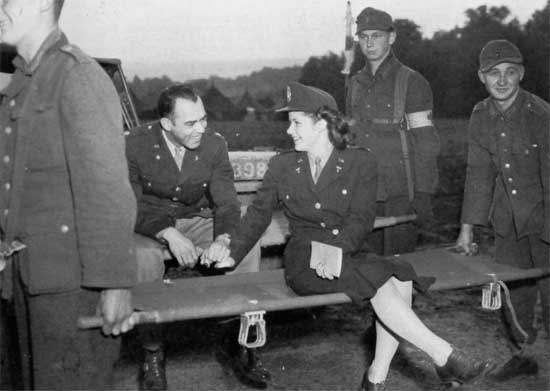
Picture of Army Nurse and groom (Army Officer) posing for the photographer, before getting on their way to the Wedding ceremony. They sit on Litters carried by captured German medical personnel (seemingly enjoying it)
However a gradually expanding number of new Base Sections, Army Hospitals, Hospital Centers and Training facilities, filled idle time and acquainted Nurses more intensively with their military duties, while the American Red Cross furnished recreational facilities. Shortages and inadequacies in clothing would however continue to plague E.T.O. Nurses throughout WW2. Over 50% of the Nurses did NOT receive the olive-drab general service uniform introduced early 1943 (requested by the Surgeon General in September 1942) to replace the (prewar) blue dress in which most of them arrived in the Theater! The situation was to gradually improve during the later war years.
Indeed, after D-Day, the situation changed dramatically; the flow of patients increased, the Nurses’ position was revised and their ‘relative’ rank changed into a ‘full commissioned’ status, T/Os were reviewed and adapted, promotion opportunities were amended and improved, and Nurses had meanwhile acquired practical medical experience in the field, and other general skills, otherwise unobtainable.
Members of the Army Nurse Corps served in Theaters all over the world. They often had to live and work under trying conditions, treating others and suffering themselves from tropical illnesses and diseases, adapting to different climatic conditions. Moreover, Nurses had to cope with inadequate supplies and lack of adapted Theater clothing. Some came under fire, others were taken prisoner, and many had narrow escapes. Deaths were unavoidable, due to hazardous duty.
In total, over 59,000 Nurses served in the Army Nurse Corps during World War 2. They now worked closer to the front lines than they had ever before. Within the “chain of evacuation”, Nurses served under fire in Field Hospitals, Evacuation Hospitals, on Hospital Trains and Hospital Ships, and as Flight Nurses on medical transport aircraft. Their skill and dedication contributed to a lower post-injury mortality rate among the American military in every Theater of Operations. African-American Nurses were only gradually accepted, because of pressure groups and overall medical necessities, but since the U.S. Armed Forces were still segregated, this was never on a large scale.
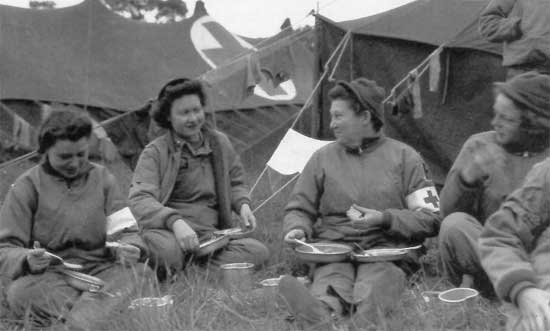
Nurses of the 13th Field Hospital are enjoying chow, picture taken on Omaha Beach. The 13th was the first Field Hospital to land on June 7, 1944 and due to a congested and only partially organized beachhead, only went into operation June 10
The tremendous manpower requirements faced by the U.S. Government during WW2 created numerous social and economic opportunities for American women – and both society and the military found an increasing number of roles for women. Women now served in many positions with the Armed Forces, either in direct or indirect support of military efforts. They were still excluded from active combat positions, but often worked in very difficult conditions, and risked their lives. Not only Nurses were on duty, in total about 74,000 women served in the United States Army and Navy Nurse Corps during WW2 (in total there were approximately 140,000 women in the Army, 100,000 in the Navy, 23,000 in the Marines, 13,000 in the Coast Guard, and 1,000 in the Air Forces). As large numbers of women entered industry and many other professions for the very first time, the need for Nurses (both in the Zone of Interior and Overseas Theaters) clarified the status of the nursing profession … Nurses were given Officers’ Commissions, retirement privileges, dependents’ allowances, and equal pay. Moreover the Government started providing free education to nursing students, as from 1943 onwards.
By June 1945, the number of Army Nurses in the E.T.O. reached a peak of 17,345. Army Nurses received 1,619 Medals, Citations and Commendations during WW2, reflecting their courage and dedication. In total, 201 Nurses died while serving. It should be noted that the A.N.C. was not made a full branch of the regular U.S. Army until April 16, 1947…
Status of American Nurses in WW2:
At the end of WW1, it had already become clear that Nurses in fact needed Officer status – partly due to the fact that sometimes male medical orderlies refused to take orders from woman Nurses! According to Army Regulations, Army Nurses were ‘ranked’ above Sergeants and Corpsmen, however in practice, AR were little known in the field and no special badges were worn by Nurses to indicate rank or authority! Nurses would finally be given relative rank in 1920. The issue was laid to rest until it came up again in WW2. By then the Chief Surgeon was urging to give Nurses more rank too – as a result of Congressional action in 1942, Nurses received pay adjustment June 16, 1942. They were now entitled to pay and allowances equal to those of male Officers! Congress subsequently authorized promotion of Nurses to the relative ranks of Major and Lieutenant Colonel, whereas previously advancement had been limited to Captain! With well over 90% of ALL Nurses in 1942 holding rank of Second Lieutenant, (this gave them a certain protection in an ALL-male world of G.I.s) the Surgeon General, under political pressure to accelerate promotion (this would place US Nurses on a more equal footing with British Nurses who held full commissioned Officer status), increased the number of higher Nurse grades in Hospital T/Os, urged the various Theaters to fill these vacancies more rapidly, and set quotas for increasing the total number of Nurses above the rank of Second Lieutenant. One of the measures was to recommend for promotion to First Lieutenant, all properly qualified Nurses who met a Theater minimum requirement of 7 months in grade and 3 months in a single position with a performance rating of “excellent”.
The overall increase of Nurses in rank above Second Lieutenant reached 4.4% in January 1944, became 11.6% in June 1944, and rose to 21% by November 1944. Congress, on June 22, 1944, finally granted Nurses full Officer status (including full retirement privileges, dependents’ allowances, and equal pay) for the duration of the War + 6 months.
Corresponding Officer relative ranks (valid in the US Army) were obtained for members of the Army Nurse Corps.Nurses held the lowest Officer rank, equivalent to that of a Second Lieutenant – Chief Nurses had a rank equivalent to that of a First Lieutenant – Assistant Directors held a rank equivalent to that of a Captain – Directors had a rank equivalent to that of a Captain – an Assistant Superintendent had a rank equivalent to that of a Captain, a Major, or a Lieutenant Colonel – a Superintendent representing the highest Officer rank, held a rank equivalent to that of a Major, later upgraded to a Lieutenant Colonel, and finally to a Colonel.
Remark:
The overall current ANC rank structure in 1943 was: 1 Colonel – 22 Lieutenant Colonels – 54 Majors – 222 Captains – 2,056 First Lieutenants – and over 33,000 Second Lieutenants.
As per AR 600-37 dated April 16, 1945, Women personnel of the Army, included ALL Officers of the Women’s Army Corps (WAC), Army Nurse Corps (ANC), Physical Therapists, Dietitians, Women Medical Officers, and Officers/Enlisted WAC personnel (except A.R.C. Workers and Staff Aides).

U.S. Army Nurses enjoying the amenities of British country life … all Nurses seem to wear the Wool Olive Drab Dark Shade No. 51 Winter Uniform, except maybe the woman to the right, which looks like she is wearing the One-Piece OD Winter Dress. Photo taken in Swindon, England, mid-April 1944. The 250th Station Hospital Nurses temporarily joined the “Nurses Provisional Battalion” at Swindon awaiting a change of Station. From L to R: Second Lieutenants Frances E. Dunning; Jean H. Duffy; Marie L. Lowe; Ann Heiser; Marion E. Castrodale; Faith A. Oldham; Gwyneth Edge; Doris M. Allshouse; Beatrice O. Patterson.
Uniform Insignia:
Army Regulations provided for a number of official Insignia for wear on Uniforms, while the Quartermaster issued Supply Catalogs and Supply Bulletins, listing the necessary Clothing and Equipment for WACs and Nurses.
Should you want more information, please click here.
Nurses:
U.S. – Nurses will wear block letters U.S. of gold-colored metal, 7/16 inch in height, each letter is to be followed by a period symbol. Insignia will be worn on both upper collars of the Service Jacket (Commissioned Officers).
Insignia of Arm or Service – Nurses will wear the appropriate Insignia of Service on both lapels of the Service Jacket, i.e. the gold-colored Caduceus, 1 inch in height, with the letter “N” superimposed, 3/8 inch in height (either in bronze finish, or in brown enamel, later standardized in black).
Insignia of Grade – Nurses (Officers) will wear the corresponding Rank on both shoulder loops of the Service Jacket, at a distance of 5/8 inch from sleeve end of loop.
When the Waist is worn without the Service Jacket, the Nurse Insignia will be worn on the left side of the collar, whereas the Insignia of Grade will be worn on the right Waist collar.
Nurses’ Cape: similar instructions will apply, i.e. A.N.C. Insignia (left) and Rank (right collar).
Nurses’ One-Piece Beige Summer Dress (Caduceus, left, U.S., right + Rank on shoulder loops) Nurses’ One-Piece Dark Olive Drab Winter Dress (Caduceus, left, U.S., right + Rank on shoulder loops), Nurses’ One-Piece Wool Dark Olive Drab Dress (Caduceus, left, U.S., right + Rank on shoulder loops), Nurses’ Cotton Seersucker Uniform (Caduceus, left, Rank, right), Nurses’ Jacket Cotton Seersucker (Caduceus, left, U.S., right + Rank on shoulder loops)…
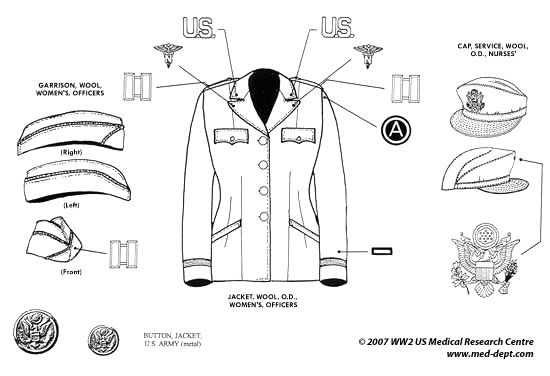
Illustration showing the placement of insignia and ornamentation on the Army Nurse Corps uniform and headgear.
Headgear Ornamentation:
Nurses:
Nurses will wear the wool olive-drab Service Cap of adopted design, with stitched semi-rigid visor covered with same material, with front strap, and center grommet to accommodate the official gold-colored Coat of Arms of the United States 2 3/8 inches in height.
When not available, or for field use, Nurses will wear the wool OD Women’s Garrison Cap, with the appropriate Officers’ braid of intermixed gold bullion and black silk, and the corresponding Officer’s Insignia of Grade, on the left of subject Cap.
Remark:
Women Medical Officers (not ANC) will wear the wool olive-drab Service Cap of adopted design, with visor and chin strap of Army Russet leather, with small regulation cap buttons, and one center eyelet to accommodate the Officers’ Cap Insignia. Above Officers could also wear the olive-drab Garrison Cap, with curtain finished with the gold-black Officer’s cord-edge braid and the specific Insignia of Grade.
Army Nurses did not possess special accessories, such as Branch Piping, Armbands, Flags, or Guidons – except they did wear Utility Bags with Shoulder Strap as part of the Uniform (different design ANC and WAC).
Organization:
Lt. Colonel Florence A. Blanchfield, A.N.C., was made Acting Superintendent of Nurses in 1942. She was appointed Chief of the Army Nurse Corps, given Army Serial Number N-1, and officially commissioned in the Regular Army. Colonel (temporary ANC grade) Blanchfield served from 1943 to 1947, and retired after more than 29 years of active service. She was awarded the DSM in June 1945 for leading the Army Nurse Corps during WW2.
Uniforms:
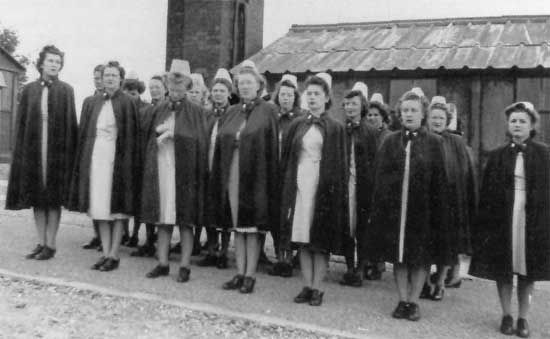
Picture showing a group of Nurses belonging to the 250th Station Hospital. Note the Nurses are wearing cotton Seersucker Uniforms with appropriate Caps, and are draped in what appears to be the old dark blue Capes. Photo taken in Grimsditch, England, end May, early June 1944, during Retreat.
Items of Uniform for the Army Nurse Corps (1944-1945)
Service Uniforms: (Winter & Summer)
The Service Uniforms to be worn by A.N.C. personnel consisted of the following items:
Cap, Service, Wool, Olive Drab, Nurses’ – Stock No. 73-C-33010
Wool Barathea Cap with Visor for wear with either the Wool or Seersucker Street Uniforms, in Olive-Drab Shade No. 51 (i.e. dark olive-drab)
Cap, Garrison, Wool, Women’s, Officers – Stock No. 73-C-24120
Wool Barathea Garrison Cap with curtain finished with Officers’ cord-edge braid, gold and black, in Olive-Drab Shade No. 51
Jacket, Wool, Olive Drab, Women’s, Officers – Stock No. 55-J-572-14
Wool Barathea Jacket for wear with Skirt, Wool, Dark Olive-Drab, as the Winter Street Uniform, with four buttons, notched collar, two simulated breast pockets with buttoned flaps, and two lower slit pockets, in Dark Olive-Drab Shade No. 51
Skirt, Wool, Olive Drab, Dark, Women’s, Officers – Stock No. 55-S-37010
Wool Barathea Skirt to match the Jacket described above, six gore style with narrow buttoned waistband, part of the Winter Street Uniform
Cap, Service, Tropical Worsted, Nurses’, Dark Olive Drab – Stock No. 73-C-30900
All-Wool Tropical Worsted Cap, same pattern and design as the prescribed Wool Winter Cap, but constructed of a strong, durable, summer weight fabric, in Olive Drab Dark Shade No. 51
Cap, Garrison, Tropical Worsted, Dark Olive Drab, Nurses’ – Stock No. 73-C-23150-100
All-Wool Tropical Worsted Cap, same pattern and design as the prescribed Wool Winter Garrison Cap, in Olive Drab Dark Shade No. 51
Jacket, Service, Tropical Worsted, Nurses’, Dark Olive Drab – Stock No. 55-J-547-70
All-Wool Tropical Worsted Jacket, same pattern and design as the prescribed Wool Winter Jacket, with lining across shoulders only, in Dark Olive Drab Shade No. 51
Skirt, Service, Tropical Worsted, Nurses’, Dark Olive Drab Stock No. 55-S-32815
All-Wool Tropical Worsted Skirt, same pattern and design as the prescribed Wool Winter Skirt, for wear with Jacket, Service, Tropical Worsted, in Dark Olive Drab Shade No. 51
Overcoat, Field, Women’s, Officers – Stock No. 55-O-2654
Trench Coat of Olive-Drab Cotton Poplin, wind resistant and water repellent, with buttoned-on Parka hood, double-breasted front with convertible collar and two slit pockets, and buttoned-in wool liner, in Olive Drab
Overcoat, Wool, Women’s, Officers – Stock No. 55-O-20040
Double-breasted Ulster type Overcoat, with convertible roll collar and notch lapel, with double row of large buttons, inverted box pleat in back held by half belt with two buttons, two outside welted pockets, and shoulder loops with small button, in Olive Drab (only available after February 1945)
Raincoat, Parka Type, Women’s, Officers – Stock No. 72-R-2511
Raincoat of coated fabric in straight cut style, with buttoned-up Parka hood, five-button front with inside storm fly, and outside ventilated shoulder yoke across back, in Olive Drab
Slacks, Women’s, Summer, Dark Olive Drab – Stock No. 55-S-39070-10
Slacks in All-Wool Tropical Worsted fabric, for wear with Jacket, Service, Tropical Worsted, Dark Olive Drab, with pleats and darts at waistline, two-inch belt with adjustable button closure, left side opening over hip, and two slash pockets at side seams, in Dark Olive Drab Shade No. 51
Slacks, Women’s, Winter, Dark Olive Drab – Stock No. 55-S-39074-10
Wool Barathea Slacks, same pattern and design as the Slacks prescribed above, in Dark Olive Drab Shade No. 51

1945 Chart illustrating Basic Training Centers for Army Nurse Corps Officers and corresponding data.
Dress and Off-Duty Uniforms: (Winter & Summer)
Cap, Service, Tropical Worsted, Nurses’, Beige – Stock No. 99-C-15021
All-Wool Tropical Worsted strong, durable, summer-weight Cap, in Beige Shade No. 55
Cap, Garrison, Beige, Women’s, Officers – Stock No. 73-C-17220
All-Rayon Shantung Cap, same pattern and design as prescribed Wool Winter Garrison Cap, for wear with Summer Off-Duty Dress, in Beige Shade No. 55
Jacket, Service, Tropical Worsted, Nurses’, Beige – Stock No. 99-J-25010-20
All-Wool Tropical Worsted Jacket, same pattern and design as previously prescribed, in Beige Shade No. 55
Skirt, Service, Tropical Worsted, Nurses’, Beige – Stock No. 99-S-45010
All-Wool Tropical Worsted Skirt, same pattern and style as previously prescribed, in Beige Shade No. 55
Dress, One-Piece, Nurses’, Summer, Beige – Stock No. 99-D-37509
Viscose Rayon Novelty Weave Dress, of shirtwaist type, with notched lapel collar, shoulder loops, long sleeves with French cuff, and Maroon braid around cuffs and shoulder loops, in Beige Shade No. 55
Dress, One-Piece, Nurses’, Winter, Dark Olive Drab (limited standard-to be issued until exhausted) – Stock No. 99-D-10009
Viscose Rayon Novelty Weave, same pattern and style as the One-Piece Beige Dress, but with self-color braid, in Dark Olive Drab Shade No. 51
Dress, One-Piece, Nurses’, Wool, Dark Olive Drab – Stock No. 99-D-40809
All-Wool Crepe, same pattern and style as the One-Piece Beige Summer Dress, but with self-color braid, in Dark Olive Drab Shade No. 51
Hospital Uniforms:
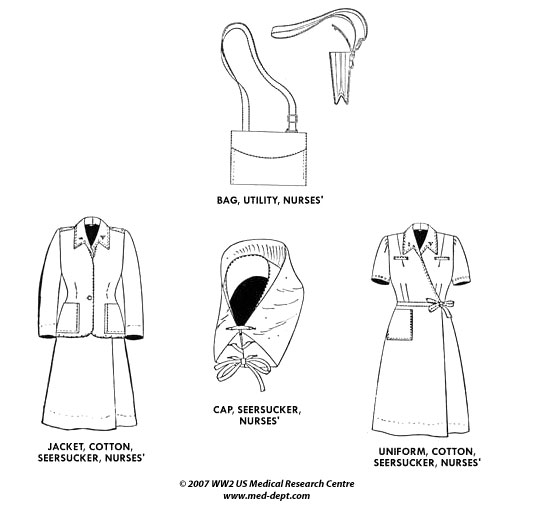
Illustration showing the general uniforms of an ANC Seersucker Nurse. Also illustrated here is the Nurses’ Utility Bag.
Cap, Seersucker, Nurses’ – Stock No. 73-C-29000
Cotton Cap for Hospital duty, opens flat and forms easily, held in place with self-lacing in the back, no ironing required, in Brown and White Stripe
Uniform, Cotton, Seersucker, Nurses’ – Stock No. 55-U-9510
Wrap-Around style Hospital Uniform, closes at waistline with tie, no buttons or other fasteners, open collar, in Brown and White Stripe
Jacket, Cotton, Seersucker, Nurses – Stock No. 55-J-180-15
Seersucker Jacket, for wear with Cotton Seersucker Uniform, for Street Wear Off-Duty, with two open pockets, and one-button front closure, in Brown and White Stripe
Cape, Olive Drab, Nurses’ – Stock No. 55-C-5910
Wool Barathea Cape in two layers, with newly designed collar and buttoned tab closure, in Olive Drab Shade No. 51
Shirt, Cotton, Seersucker, Nurses’ – Stock No. 55-S-2102
Cotton Shirt-Waist Seersucker, with convertible collar and one-button closure, two-buttoned flap pockets, long shirt-type sleeves with buttoned cuff closure, for wear with matching Slacks, Cotton, Seersucker, in Brown and White Stripe
Slacks, Cotton, Seersucker, Nurses’ Stock No. 55-S-38905
Cotton Seersucker Slacks, for wear with matching Shirt, Cotton, Seersucker, with pleats and darts at waistline, left side opening with slide fastener closure, slash pocket at right side seam, in Brown and White Stripe
Accessories for Nurses’ Uniforms:
Bag, Utility, Nurses’ – Stock No. 74-B-56-35
Leather Handbag with pockets and change purse, olive-drab cotton poplin lining, with adjustable and removable strap, in Army Russet Color
Necktie, Maroon, Nurse – Stock No. 99-N-50000
Rayon Faille fabric Necktie, for wear with White Waist and Jacket, Service, Summer, in Maroon Shade No. 57
There were more additional accessories, such as a transparent waterproof cover for the Wool Winter or Summer Cap, and another one destined for the Garrison Cap. The other items covered cloth, buttons, and respective cap and collar insignia.
Remark:
It was the responsibility of the QMC to make available all essential Items of Clothing to Women stationed overseas. Quartermaster Officers were to take all necessary measures to facilitate the supply of items to Nurses, WACs, Red Cross workers and other authorized personnel in overseas areas. All items of Clothing (see above descriptions) were available for sale to all Women authorized to purchase the goods. Items carrying the 99 Series of Stock Numbers were not regular Items of issue, and were thus only procured by the Quartermaster Corps in limited quantities! In case supplies or requisitions were insufficient, women sometimes were issued, or purchased, WAC items as a substitute.
The above lists do not include Hosiery, Underwear, Nightwear, Footwear, General Clothing, Field Wear, and Accessories, such as Gloves, Handkerchief, Bandana, Necktie, Scarf, and Dress Shields, which were partly covered by Mandatory Clothing & Individual Equipment Allowances, and Mandatory and Optional Clothing Purchases (let’s not forget Officers had to purchase some of their clothing).
For those interested in Women’s Clothing, it should be noted that the Women’s Army Corps (WAC), the United Services Organizations (USO), the Hostesses and Librarians, and the American Red Cross (ARC) workers, all had their own official Uniforms and Insignia.
Female personnel designated as Correspondents, Journalists, Photographers, Radio Commentators, Technical Observers, and Service Specialists, were authorized to procure a WAC Commissioned Officer’s Uniform, less Insignia of Grade and Arm or Service – female personnel employed as Messengers and Chauffeurs by above personnel, were authorized to procure the Uniform of a WAC Enlisted Woman, without any Insignia

WW2 recruitment poster designed to encourage women to actively become involved with the Army Nurse Corps.
Other women in uniform emerged from training and took their places at Army Posts, Army Airfields, and Naval Bases, dressed in khakis, blues, olive drab, greens, and grays, effectively releasing able-bodied men for combat duty. They belonged to the WAAC (established May 1942 – Women’s Army Auxiliary Corps), later replaced by WAC (established July 1943 – Women’s Army Corps), WASP (established August 1943 – Women’s Air Force Service Pilots), WAVES (established July 1942 – Women Accepted for Volunteer Emergency Service), and SPAR (established November 1942 – Women’s Reserve US Coast Guard).
